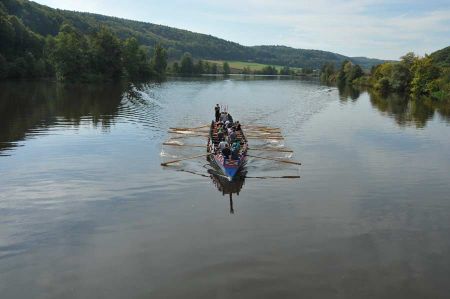Encounter on the Naab - living Roman history
- Written by Portal Editor
As part of our project "Comprehension and Cultural Journey along Roman Roads" we came to Regensburg (Castra Regina) again to support the further preparation of the "1st German-Turkish Literature and Encounter Festival Regensburg".
Of course, we also wanted to use our presence to visit other destinations along our project tour and get to know them on our first visit. Once again, we used the Pielenhofen an der Naab campsite, which had already been the starting point for our explorations several times.
Crossing the Mariaort railway bridge over Danube
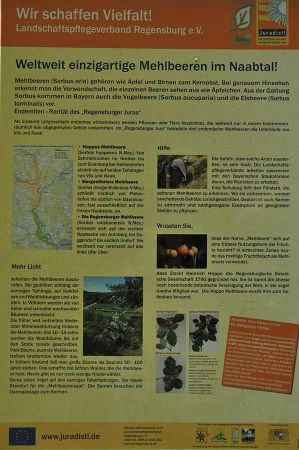 We had already reported in detail about our bike tour along the Naab towards Kallmünz, now we should go down the Naab towards Regensburg, where the Naab flows into the Danube at Mariaort, about 7 km from the gates of Regensburg. We had chosen the Mariaort pilgrimage church as the first destination for today's tour, which is reached after crossing the Naab using a wooden bridge. From here, after crossing the Mariaort railway bridge over the Danube, we continue on the Danube cycle path towards Regensburg and Kehlheim.
We had already reported in detail about our bike tour along the Naab towards Kallmünz, now we should go down the Naab towards Regensburg, where the Naab flows into the Danube at Mariaort, about 7 km from the gates of Regensburg. We had chosen the Mariaort pilgrimage church as the first destination for today's tour, which is reached after crossing the Naab using a wooden bridge. From here, after crossing the Mariaort railway bridge over the Danube, we continue on the Danube cycle path towards Regensburg and Kehlheim.
The Naab Radweg leads directly behind the campsite, then first along extensive corn fields, later through stands of trees near the banks, which almost completely hide the residents' small gazebos. In addition to a number of idyllic, pretty weekend houses, we come across a few camping trailers that are used for local recreation on private land, but also a former construction trailer that also represents a wonderful weekend idyll on the edge of a meadow with a large panoramic window. We often meet canoeists who use the river for an excursion when the temperatures are still summery. The cycle path is, at least our impression, used very extensively. In addition to cycle hikers, we meet mountain bikers and really fast racing cyclists, a colourful mix of outdoor-loving people.
Endemic rarity of the “Regensburg Jura”
 Also interesting was the information board about the mulberries in the Naab Valley, which, like apples and pears, are pome fruits and are considered an endemic rarity of the "Regensburg Jura".
Also interesting was the information board about the mulberries in the Naab Valley, which, like apples and pears, are pome fruits and are considered an endemic rarity of the "Regensburg Jura".
Animals or plants that only occur in a specific, spatially clearly defined area worldwide are referred to as endemic. In the "Regensburg Jura" three endemic whitebeams populate the lower reaches of Vils and Naab.
The risk of such species becoming extinct is very high. The landscape conservation associations are therefore working with the Bavarian State Forests to preserve these rarities.
Training helps foresters recognize these rarities. Where they occur, shading wood is cut back. It is also planned to collect seeds and plant grown specimens in suitable locations.
 The whitebeams always seem to be calling for lighter, because they thrive best along the sunny valley slopes, on limestone cliffs and forest clearings. In the forests they are often suppressed by the faster growing trees and bushes.
The whitebeams always seem to be calling for lighter, because they thrive best along the sunny valley slopes, on limestone cliffs and forest clearings. In the forests they are often suppressed by the faster growing trees and bushes.
The previously widespread use of middle forests once promoted whitebeams. The forest trees used to be cut back to the cane every 10 - 15 years. Many trees, including whitebeams, sprout again without any problems. Large trees were left to stand at a clear distance as lumber for 50 - 100 years.
This used to create the sparse forests that whitebeams love and allowed them to thrive splendidly.
Wooden bench with a view of the Naab confluence with the Danube invites you to linger
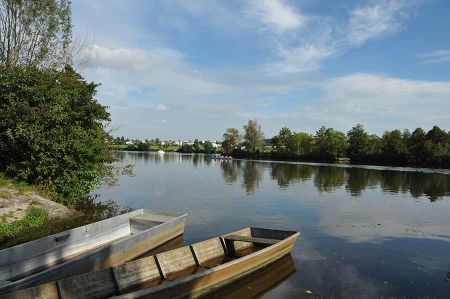 The further course of the cycle path is a little disappointing, as it then leads for a few kilometres along the busy B8 towards Regensburg.
The further course of the cycle path is a little disappointing, as it then leads for a few kilometres along the busy B8 towards Regensburg.
Since there are some sections right next to the B8 road, the headwind and the noise from passing vehicles are quite unpleasant. Perhaps in the future there will be options and steps to allow the Naab cycle path to follow the course of the Naab, away from the main road, or to improve the signage so that it is easy to recognize a possible replacement route.
In any case, we make the decision to leave the main road at the first opportunity and get into Mariaort.
Row vigorously to keep the ship on course
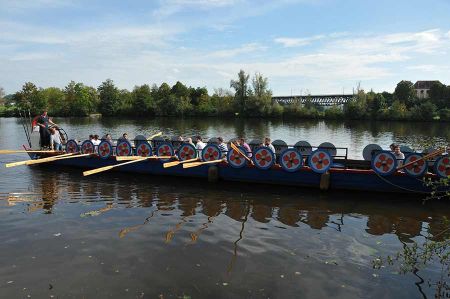 It's not far to the wooden pedestrian/cyclist bridge and a wooden bench with a view of the Naab confluence with the Danube invites you to linger. A little later, as we want to continue on our way, we see a large rowing boat coming down the Naab.
It's not far to the wooden pedestrian/cyclist bridge and a wooden bench with a view of the Naab confluence with the Danube invites you to linger. A little later, as we want to continue on our way, we see a large rowing boat coming down the Naab.
Of course, we had already heard about the "Roman boat" that had been rebuilt by a group of Regensburg students under the guidance of Professor Konen, a galley from the "Navis Lusoria". But it was pure coincidence that we should now see this rowing boat, well crewed and in full action, on the Naab.
As we could certainly observe from above, the pseudo-Romans on board also had to row vigorously to keep the ship on course. This impressively created a very intense impression of the hardships Roman soldiers once had to endure and the discipline that was required.
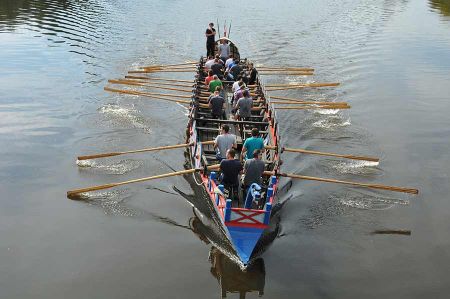 Basically, the Romans were not initially a seafaring people; their boat technology initially consisted of taking over Greek ships. Only in the course of their expansion history did they maintain a huge fleet of rowing and sailing boats; they had around 1,000 ships on the Rhine alone. These ships monitored the "wet" Limes borders and were needed to transport troops and goods to supply the soldiers. There were cargo ships that carried people, animals, equipment, building materials and food.
Basically, the Romans were not initially a seafaring people; their boat technology initially consisted of taking over Greek ships. Only in the course of their expansion history did they maintain a huge fleet of rowing and sailing boats; they had around 1,000 ships on the Rhine alone. These ships monitored the "wet" Limes borders and were needed to transport troops and goods to supply the soldiers. There were cargo ships that carried people, animals, equipment, building materials and food.
The boats and ships were up to 25 m long and up to 7 m wide. They had a flat keel so that they could sail in rivers where there was very little water. There were also smaller ships, 15 m long and 3 m wide, which were more manoeuvrable and were moved by 10 rowers. They served as reconnaissance ships, patrol boats, guard and escort ships for barges or as troop transports. However, there were also real warships. They had a ram and were manned by sailors and soldiers. Up to 44 rowers sat in two rows one above the other on either side.
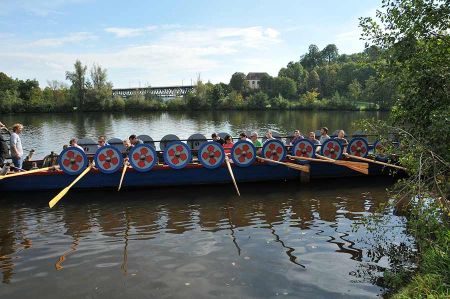 Under Emperor Claudius (41-54) the construction of the Oberstimm border fort was completed around 40/50 AD as part of securing the upper Danube.
Under Emperor Claudius (41-54) the construction of the Oberstimm border fort was completed around 40/50 AD as part of securing the upper Danube.
It is one of the oldest forts in the province of Raetia and in its time, it was the easternmost garrison on the upper Danube. From here down the Danube there was a big gap in border surveillance, because the next fort was only in Linz. The Oberstimm fort was not only responsible for border protection, but with its workshops it was also designed as a supply base for the mainly mounted units and small camps deployed eastwards to guard the border.
The choice of location determined - similar to the Celtic town of Manching - the intersection of two important traffic routes: the north-south connection across the Danube and an east-west path on the lower terrace south of the river.
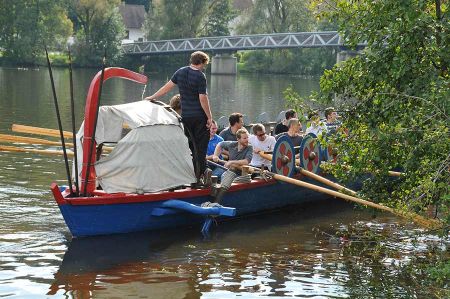 In 1986, immediately west of the fort, archaeologists discovered two spectacular Roman military ships of Mediterranean design from around 100 AD in the area of a silted Roman pier, which were used by the Roman military as patrol boats and for escort.
In 1986, immediately west of the fort, archaeologists discovered two spectacular Roman military ships of Mediterranean design from around 100 AD in the area of a silted Roman pier, which were used by the Roman military as patrol boats and for escort.
They were excavated as planned in 1994 and were in the Roman-Germanic Central Museum in Mainz, which is known worldwide for its museum workshops, for conservation and restoration until 2005. The two 2,000-year-old shipwrecks from Oberstimm are considered to be the best-preserved Roman boats north of the Alps.
Today these two ships can be viewed in the Celtic and Roman Museum in Manching.
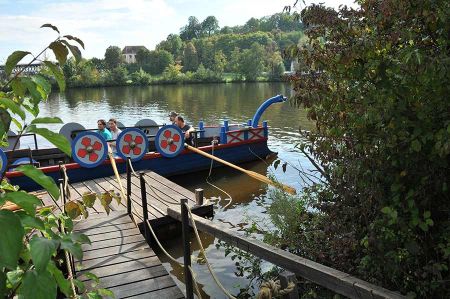 In any case, we look at the rowing manoeuvres of the replica Roman ship with great interest. On command, the 16 rowers dip their oar blades into the water and “pull” the boat forward. Then the turning manoeuvre takes place, because the Roman boat's berth is just before the confluence with the Danube. Now only the rowers on the starboard side are required. Here, too, at the signal of the rudder commander, the rudder blades are dipped and "pulled" at the same time, so the turning manoeuvre is successful without any major complications, even if the group of rowers can generally be viewed as beginners. More passers-by have long since gathered on the cycle bridge who want to witness the rare spectacle. And so we learn from a cyclist about the story that began here in 2006.
In any case, we look at the rowing manoeuvres of the replica Roman ship with great interest. On command, the 16 rowers dip their oar blades into the water and “pull” the boat forward. Then the turning manoeuvre takes place, because the Roman boat's berth is just before the confluence with the Danube. Now only the rowers on the starboard side are required. Here, too, at the signal of the rudder commander, the rudder blades are dipped and "pulled" at the same time, so the turning manoeuvre is successful without any major complications, even if the group of rowers can generally be viewed as beginners. More passers-by have long since gathered on the cycle bridge who want to witness the rare spectacle. And so we learn from a cyclist about the story that began here in 2006.
In the summer of 2006, a group of scientists and adventurers set off from Regensburg to Budapest in a faithfully reconstructed Roman galley. For the first time in 1,600 years such a ship sailed this route on the Danube. At that time, a team from Bayerischer Rundfunk accompanied the boat on the exciting expedition into the past, which was both a scientific experiment and a top sporting achievement. Scorching heat, but also cold, rain and storms make things difficult for the rowers.
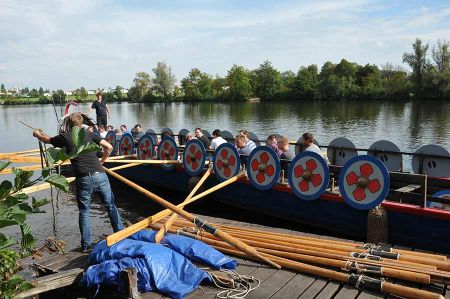 The film created from the accompaniment shows the team in moments of highest motivation, but also moments of disappointment and doubt. You get to know Mr. Dorfmann, a 76-year-old adventurer from the Black Sea, and Julia, the then 19-year-old, petite student. You experience the captain, who is actually a teacher and has to learn to command the team loudly. And also, the boat builder Frank Jäcklein, who joined the boat building project as a journeyman on the Walz and hasn't left it since. You and the entire team led by Dr. Heinz Konen helped the University of Regensburg's project to be a tremendous success. After 180,000 rowing strokes per person and almost 800 kilometres of river, the team went ashore in Budapest: enriched by some scientific knowledge, but also with a unique experience.
The film created from the accompaniment shows the team in moments of highest motivation, but also moments of disappointment and doubt. You get to know Mr. Dorfmann, a 76-year-old adventurer from the Black Sea, and Julia, the then 19-year-old, petite student. You experience the captain, who is actually a teacher and has to learn to command the team loudly. And also, the boat builder Frank Jäcklein, who joined the boat building project as a journeyman on the Walz and hasn't left it since. You and the entire team led by Dr. Heinz Konen helped the University of Regensburg's project to be a tremendous success. After 180,000 rowing strokes per person and almost 800 kilometres of river, the team went ashore in Budapest: enriched by some scientific knowledge, but also with a unique experience.
Today the boat is often booked by schools or groups who want to experience this experience themselves, at least for a few hours. So it's no wonder that we're talking about an almost unique experience.
Despite all the contemplation and discussions, time has progressed so much that we decide to return to the Pielenhofen campsite. Here’s to something new in the coming days, when we will hopefully reach Regensburg by bike.
Please read as well:
Wine cellar Plže - Petrov and its cap vaults
Drilon - idyllic green park landscape near Pogradec
https://www.alaturka.info/en/germany/bavaria/6276-encounter-on-the-naab-living-roman-history#sigProId646423b422
